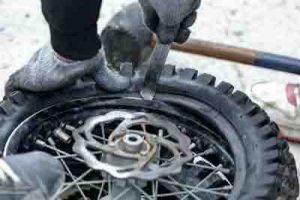The not too heavyweight of a motorcycle allows you to be able to ride on a flat tire for a considerable distance before you find a repair shop.
Depending on the size of the wheel of your motorcycle or how flat your tire is, you can ride between 6 to 10 miles before the wheels or rim completely totals to the point where you are unable to use it anymore.
And this while you ride at low speed. Any distance longer or a speed faster and you risk an accident that would cost you more in repairs.
Table of Contents
What happens if the rear tire goes flat on a motorcycle?
Flat tires are an occurrence always waiting to happen down the road. They are to be expected.
This happens no matter how careful you are because you can’t control all the factors on the highway – there’s a nail waiting to puncture your tire, the side of a deep pothole to cause a blowout, and so forth.
Any of your tires can experience a flat, the tricky thing is, with a motorcycle, you may not immediately realize you have a flat if you aren’t paying attention.
So what happens when it is the back tire of your motorcycle that goes flat? Well, there are signs to note when it’s the back tire that’s down.
If the flat happens when your bike is parked, it is obvious but the following scenarios I’m going to describe happen when your motorcycle is in motion.
- The tire wobbles and hums
- The motorcycle feels like it is losing power
- The ride feels rough
The tire wobbles and hums
When your motorcycle is in motion and is going flat, you’ll feel the sensation of imbalance as you ride it. The back tires which are flat will wobble.
Every revolution comes to that spot where the tire is most tender, where it is punctured causing it to wobble and hum.
The motorcycle feels like it is losing power
Since the rear tires specifically receive power directly from the engines, it will drag, making the motorcycle slow down. This is because of excess contact with pavement on account of the flat tire. Pumped tires roll better, and vice versa.
The ride feels rough
Yes, this is one of the classic signs your rear tire is kaput. Picture yourself riding on the smooth highway, along the countryside where the pavement is mostly smooth but your motorcycle feels like you’re galloping through a wilderness, rough terrain with all the little bumps and all.
That’s exactly how it feels when your rear tire is flat.
What happens if you keep riding on a flat motorcycle tire

The advice I give straight off the bat is; do not continue to ride the motorcycle if the tire is flat.
It begins with slow leaks that eventually flatten your tire. And you’ll have to pull over and get your tire fixed. But a different scenario presents itself where you insist on riding on with a flat tire.
Let’s say you maintain a high speed, which is most unlikely since a flat tire invariably slows your motorcycle down, you will experience any of the following:
- Your control over the motorcycle is reduced
- Permanent damage to the rim of your wheel
- Your tire’s inner tube will be damaged
- An accident is likely to occur
Your control over the motorcycle is reduced
As I’ve mentioned before about what happens with a flat tire, the bike would slow down, the more you ride on the flat tire, the less control you have over the performance of the motorcycle. You want to go faster, but your bike and you aren’t on the same page anymore.
Permanent damage to the rim of your wheel
The less pressure your tire has as it leaks from the puncture, the more damage your rim is exposed to. For one thing, the rim pinches the tire and probably shreds it as you ride.
When there’s not enough rubber to protect the rim from the pavement, the rim is now subjected to permanent damage as it meets the hard pavement.
Your tire’s inner tube will be damaged
Depending on the type of tube you use, the increase in temperature that results from the flat can cause irreparable damage to the inner tube.
When the rim begins to contact with the pavement, it hears up the whole wheel structure, a latex tube suffers high temperature and if caught between the rim and pavement in a pinch, will complete shred.
An accident is likely to occur
Yes, you could have an accident if you notice your tire is flat but you keep riding at high speed. But of course, I don’t expect you to speed up with a flat tire since you don’t have a death wish.
Still doesn’t remove the possibility of an accident. For one thing, the back end of your motorcycle will whip back and forth, side to side if your tire bursts while on the move.
But this happens long after you notice an initial wobbling of the tire or a reduction in speed. Whatever the case may be, it is best not to ride with a flat tire.
What should you do when your motorcycle goes flat?
Do the following:
- Roll-off the throttle, gradually and gently. Wait for the motorcycle to slow down naturally then apply both brakes gently – if you are not sure which of your tires is flat. Apply the brake of the tire that isn’t flat, if you are aware of which.
- Do not try to try to change direction too quickly or turn off the road. Achieve a change in direction as naturally as you can. A sharp or sudden turn will cause your motorcycle to flip and the consequences can be fatal if you have oncoming vehicles behind you.
- As you apply the brake align your body with the chassis of the motorcycle to keep it from excessively whipping from side to side.
- Aim for the shoulder of the road. Get off the fast lane to avoid speeding road users from ramming into you from behind.
- Cautiously control the motorcycle to a stop and get off to examine the damage.
What follows next is repairs. If you are carrying a piece of temporary-fix equipment, then you can go ahead and do the fix. But if not, locate a repair shop.
To fix the flat tire yourself you have to assess the damage. Look for the puncture. You have to admit that a flat that causes you to pull over is usually beyond something you can fix by yourself.
Yet it does your mind a measure of good to see for yourself how much damage has been caused.
If it’s a nail and it’s still in your tire, you likely have a punctured tube as well. In this case, you’d have to find a repair shop. At any rate, all you can do you have done by parking safely.
At this point, call a friend to come and get you. If however, you feel the location you are isn’t safe to be alone, then you can push the bike to the nearest repair shop or somewhere you can make a phone call for help.
Safety tips for motorcycle tires
There are many reasons to treat your motorcycle with the same energy you accord your health. Every time you get on your motorcycle for a ride, you place your life in the hands of a mechanical entity, a machine.
However, your motorcycle’s output and how it treats you depend so much on how you’ve been treating it.
The following safety tips help you spot any problems there may be with your tire:
- Always check your motorcycle tires for foreign objects sticking out of them before taking them out for a ride. Objects like nails, screws, and any other sharp things. Some of these objects lie around the garage or drive. Or a vengeful enemy may stick one in your tire. The earlier you spot them, the safer.
- Check the PSI, or air pressure level before every ride you take your motorcycle on. It is normal for tires to lose a certain amount of PSI even when they are not in use. Do not allow the accumulation of loss of pressure. Always check the gauge.
- Check the tread depth. Tires lose tread depth over time. Tread depth is essential for tires to perform at optimum levels. Tires are tough and withstand even some punctures. But if the tread depth is below 1 mm across the central region of the tire, the tire is due for changing.
- Check for cracks in the sidewall, around the rim, the spokes. Cracks can occur in tires due to aging, prevailing temperature, and storage. Constant use in rough terrains also cracks the tire. A cracked rim is likely to cause a flat too.
- Check for punctures. A puncture may take a while to manifest if the nail culprit entered and fell off again. If this happens and dirt enters the puncture, it is blocked but leaks air slowly.
- Check the chains. Now, this isn’t exactly tire but it is included here because they are attached to your motorcycle tires. Check them too along with your tires to make sure they’re not too loose or overtightened. Make sure they are lubricated properly too.
- Check the age of your tire. A tire might appear healthy on the surface but upon closer examination, you might notice degradation in the tire wall.
Regular checks can reveal if your tires are in their optimal condition, and help avoid flats.
Quick fixes for motorcycle tire blowout

You do not need a new tire every time your tire goes flat. The exigencies of a new tire are reduced especially if you experience a flat while out on the trail.
Sometimes when you have a flat the nearest repair shop is miles away, to make the situation worse, the connection sucks so much you can’t make a phone call for help. What then?
Here is an outline of a quick fix for your flat motorcycle tire if your tire is a tubeless motorcycle tire:
Tools for fixing motorcycle tire
- Motorcycle repair kit: Many kits come with a string plug.
- Hand pump: you’ll need this to put air back in the flattened tire to get it back in shape.
- Utility knife: your kit contains a utility knife, hopefully.
- Tire pressure gauge: you need this to make sure the pressure meets manufacturer specifications.
Steps to fixing tubeless motorcycle tires
- Find the Puncture: make a visual inspection of the tire to see if you can find the nail or object responsible for the puncture. Listen for a hissing sound. If you still are not able to find the puncture, use soapy water by pouring it all over the tread, the leaking spot will bubble.
- Now use your reaming tool to work the hole to make it more obvious. Run the tool in and out, side to side. Tires are tough so it will require some effort. Keep the reaming tool in.
- Now get your plugging tool and run the plugging tread through the eyelet of the plugging tool. Trim the sides of the tread so that equal halves of it is protruding from the eyelet of the plugging tool. Get the reaming tool out of the puncture, push it in at least ¾ of the way. Now, take a breath and relax. Yank the plugging tool back.
- Use your utility knife to trim the excess plugging material so that it becomes flush with the surface of the tire. Leave the plug to set with the tire for about 10 minutes.
- When you are certain the plug is set, get your hand pump and inflate your tire to the recommended pressure.
- Voila! Get back on your bike and, au revoir.
Tools to fix tube-type motorcycle tires
- Tire repair kit
- Tire hand pump.
- Tire levers.
- Tire lube.
- Valve stem removal tool.
- Rim protectors.
- Tire pressure gauge.
Steps for fixing tube-type motorcycle tires
- Find the puncture. Remove the nail if you find it. Then unmount the tire from your motorcycle.
- Get the tire off the rim. Use a bead breaker if you have one with you to make it easier. Use a tire iron in this process to get the tire off the rim.
- Pull out the tube and using your tire patching kit, patch the hole in the tube.
- Once you have patched the tube, reinsert the valve stem in its spot in the rim.
- Inflate the tire with your hand pump but not completely.
- Fit the tube back in your tire and complete the inflation.
- Check the pressure with your gauge to make sure it meets manufacturer specifications.
Takeaway
There, your tire is back, right as rain, good as new. Finally, make sure to follow a periodic check on your tires. Doing so may mean saving your life. And always carry a repair kit, you just never know.


1 thought on “How Long Can You Ride On a Flat Motorcycle Tire?”